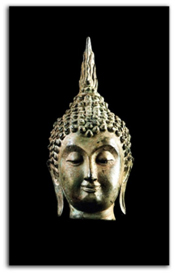By Lanier Graham
SACRED WORKS OF ART

Bronze Head of Buddha with a Flame from the Crown Chakra. Thailand. 17th/18th century
The flame rising from the top of the head represents the transcendent light of true wisdom. Sometimes called the Lotus Blossom Flame, this dynamic ushnisha was continued in Thai art for centuries. The traditional teaching is that the rise to Buddha-Consciousness involves raising awareness from its lowest levels to its highest levels. The energy-centers or gateways known as ‘chakras’ are levels in the ladder of awareness that must be climbed. The number of levels varies from one meditative tradition to another but 7 is a common number in meditative traditions world-wide. In this way of counting the so-called Third Eye at the center of the forehead is the 6th chakra marking a very high level of spiritual understanding. It usually is marked by a dot called an urna. The level above that- the ‘7th Heaven’ where Buddha-Consciousness unfolds is said to be located just above the top of the head. If the cranial protuberance on the top of a painted or sculpted Buddha is simply a rounded shape, that shape has come to be called a ushnisha. The urna and the ushnishna are common in Buddhist art from India to China. But the “flaming chakra” is particular to the art of Thailand. It is a beautiful way to symbolize not only ‘Golden Consciousness’ in general and in particular to visualize in a material way the dynamic luminous non-material energy that is said to connect the physical body with the non-physical body just above the head.
Originally published in Global Vision: A Survey of World Art, Part 1, 2006
The sacred art objects shown in this series come from the collection of over 200 works donated to the Graduate Theological Union by the Lanier Graham family and the Institute for Aesthetic Development in 2014-2015. The collection represents most of the world religious traditions including tribal or indigenous art. The GTU intends to photograph and curate this collection as an online resource accessible by the public.

